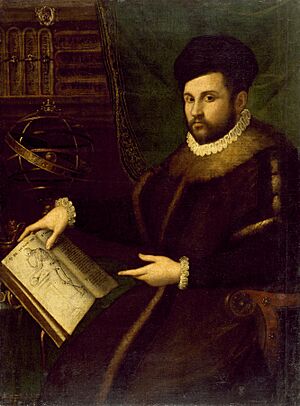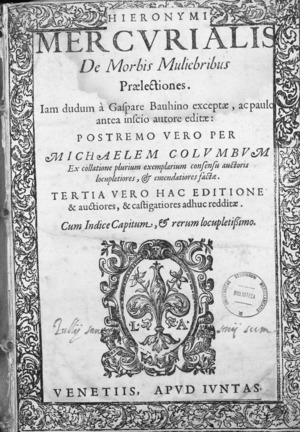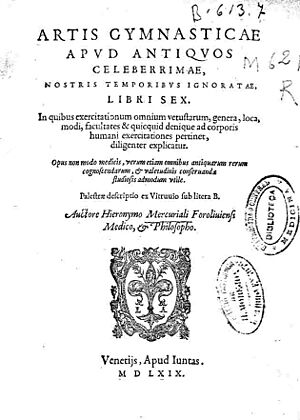Girolamo Mercuriale facts for kids
Quick facts for kids
Girolamo Mercuriale
|
|
|---|---|

Girolamo Mercuriale
|
|
| Born | September 30, 1530 |
| Died | November 8, 1606 (aged 76) Forlì
|
| Nationality | Italian |
| Alma mater | University of Padua, University of Bologna |
| Known for | De arte gymnastica |
| Scientific career | |
| Fields | Medicine, Botany |
| Doctoral students | Gaspard Bauhin |
Girolamo Mercuriale was an important Italian doctor and scholar who lived a long time ago, from 1530 to 1606. He is best known for his book De Arte Gymnastica, which was all about exercise and health in ancient times. He also wrote many other books on different medical topics.
Contents
Girolamo Mercuriale: A Pioneer Doctor
Early Life and Education
Girolamo Mercuriale was born in Forlì, Italy, on September 30, 1530. His father, Giovanni Mercuriali, was also a doctor. Girolamo studied at famous universities in Bologna, Padua, and Venice. He earned his doctorate degree in 1555.
After finishing his studies, he went back to Forlì. From there, he was sent on an important trip to Rome. At that time, Pope Paul IV was the leader of the Catholic Church.
Discovering Sports Medicine
While in Rome, Girolamo made many helpful friends. He also had special access to the amazing Vatican libraries. There, he eagerly studied old books about medicine from the ancient Greeks and Romans.
He learned a lot about how people in ancient times thought about food, exercise, and hygiene (staying clean). He was very interested in how they used natural methods to treat sickness. All his studies led him to write his most famous book, De Arte Gymnastica. It was published in Venice in 1569.
This book explained the ideas behind physical therapy. Because of this, it is seen as the first book ever written about sports medicine. The pictures in the second edition of his book (from 1573) helped people imagine what ancient sports were like. However, we now know that many of these pictures were made up by Mercuriale and his helpers.
Helping Emperors and Patients
The book De Arte Gymnastica made Mercuriale very famous. In 1569, he was asked to become a professor of medicine at the University of Padua. While teaching there, he translated the writings of Hippocrates, a very famous ancient Greek doctor.
With this new knowledge, Mercuriale wrote several other important medical books:
- De morbis cutaneis (1572) – This was the first scientific book about skin diseases.
- De morbis muliebribus (1582) – About women's diseases.
- De morbis puerorum (1583) – About children's diseases.
- De oculorum et aurium affectibus – About eye and ear problems.
In his book about children's diseases, Mercuriale wrote about how children were raised back then. He noted that mothers usually stopped breastfeeding their babies completely after about 13 months.
In 1573, Mercuriale was called to Vienna to treat the Holy Roman Emperor Maximilian II. The emperor was very happy with Mercuriale's treatment. Even though the emperor passed away three years later, he made Mercuriale an imperial count palatine, which was a high honor.
Facing the Plague in Venice
Mercuriale returned to Italy. In 1575, the government of Venice offered him a six-year job as a professor at the University of Padua. He was seen as a hero in Venice.
However, his reputation faced a big challenge during the plague outbreak in Venice from 1575 to 1577. The Venetian government asked Mercuriale to lead a team of doctors to advise them about the disease.
Mercuriale believed the sickness in Venice was not the true plague. He argued against using quarantines and special hospitals called lazarettos. He and another doctor, Girolamo Capodivacca, even offered to treat the sick themselves. They said they would do this if the quarantines were lifted.
The professors and their assistants moved freely between sick and healthy homes. This worried the health officials in Venice and nearby cities. When Mercuriale and Capodivacca started their work, the number of deaths had almost stopped. This made them even more sure it wasn't the real plague.
But by the end of June, the death rate began to rise very quickly. By early July, the government ordered Mercuriale and Capodivacca to be quarantined themselves. Many people believed their methods caused the plague to spread. The plague eventually killed 50,000 people in Venice, which was one-third of the city's population.
Despite this, Mercuriale was able to improve his reputation. In 1577, he published De Pestilentia, his own book about the plague. This book was based on lectures he gave at the University of Padua.
Later Career and Legacy
Mercuriale was a very active writer. Many books were put together from his notes and lectures. He stayed at the University of Padua until 1587. Then, he began teaching at the University of Bologna.
In 1593, Ferdinando de' Medici, the Grand Duke of Tuscany, invited him to Pisa. The Grand Duke wanted to make the university there more famous. He offered Mercuriale a very high salary, starting at 1,800 gold crowns. This would increase to 2,000 gold crowns after two years.
Mercuriale returned to his hometown of Forlì in 1606. He passed away there a few months later.
Many students learned from Mercuriale. One of his famous students was the Swiss botanist Gaspard Bauhin. Another was the Polish doctor Jan Chrościejewski.
In 2009, the Olympic Museum in Lausanne held an event to remember Girolamo Mercuriale. It marked 400 years since his death.
Works
Here are some of the important books written by Girolamo Mercuriale:
- Artis gymnasticae apud antiquos celeberrimae, nostris temporis ignoratae, libri sex. Venice, 1569. (This is his famous book on ancient exercise and health.)
- De morbis cutaneis, et omnibus corporis humani excrementis tractatus locupletissimi..., Venice, 1572. (About skin diseases.)
- De pestilentia, Venice, 1577. (His book about the plague.)
- De morbis puerorum tractatus locupletissimi..., Venice, 1583. (About children's diseases.)
- De venenis, et morbis venenosis tractatus locupletissimi..., Venice, 1584. (About poisons and poisonous diseases.)
- De morbis muliebribus libri, Venice, 1587. (About women's diseases.)
- Variarum lectionum, in medicinae scriptoribus & aliis, libri sex, 1598.



